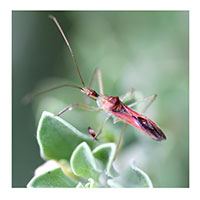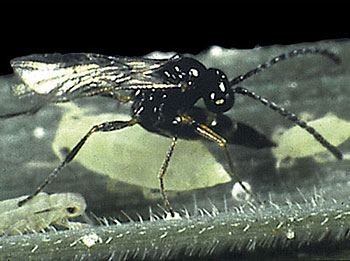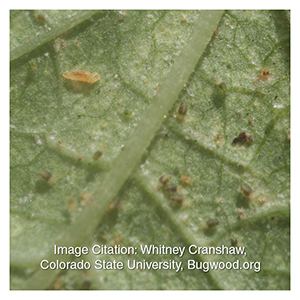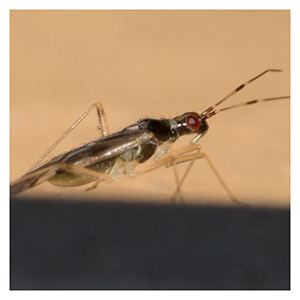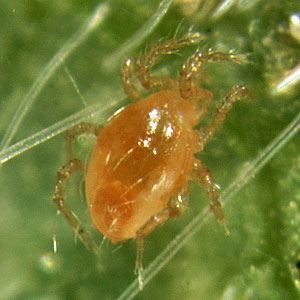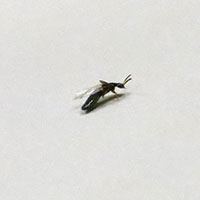The
Leafhopper Assassin Bug, Zelus renardii is a hardworking ambush predator that is an excellent addition to any growing area – large or small. Contrary to what their common name suggests,
Leafhopper Assassin Bugs are generalist predators that feed on a variety of small to medium sized plant pests including aphids, mealybugs, small caterpillars, thrips and more.
Assassin Bugs begin feeding immediately after hatching. After reaching the second instar phase of their life cycle, they produce a resin on their legs. This resin allows
Zelus renardii to efficiently trap and kill their prey as they move around.
Assassin Bugs capture and kill prey by piercing with their rostrum and injecting a digestive enzyme. This method of predation allows
Assassin Bugs to rapidly kill prey that is much larger than they are. These
generalists kill and eat a wide variety of small to medium sized insect; they are voracious and very efficient in gardens, fields, orchards and greenhouses.
Their life span is approximately 2 months, which allows them to provide ongoing relief from pest infestations in the area of release. It can take a week to 10 days for eggs to hatch, so take that into account when planning your
Integrated Pest Management approach. Once hatched,
Assassin Bugs are likely to stay in the treatment area until their food sources have diminished making them a suitable alternative to
ladybugs in warmer climates.
Assassin Bugs should not be used alone for infestations of
spider mites. They are excellent when used in combination with other
mite predators suitable to the growing environment.
Stop aphid infestations early with these aphid parasites! Aphidius colemani can be used as a preventative or active control measure.
Aphidius colemani is a small parasitic wasp, native to North America that specifically targets aphids. These tiny (1/8" or 2-3 mm) parasitic wasps seek out aphid colonies to provide food and a place to oviposit. Adult
A. colemani respond to alarm signals from plants to locate the aphids where they feed on the honeydew aphids excrete. Parasitization occurs when females lay their eggs inside aphid nymphs.
A. colemani eggs hatch into larvae which feed on the nymphs from the inside, the nymph swells and hardens into a leathery, grey or brown colored mummy similarly to effects of
Aphelinus abdominalis. Once larvae mature, adult
A. colemani wasps chew their way out of the aphid mummy and emerge to seek out aphids. These parasites are a good choice for year-round use (in greenhouses and outdoors) as the short days of winter do not affect them.
Preferred food: Honeydew, the sticky fluid produced by aphid infestations.
For Developing Soil Stage Control of Fungus Gnats, Thrips and Springtails.
This tiny, translucent brown to tan predatory mite naturally inhabits the top layer of soil where pest insect larvae and pupae dwell.
Stratiolaelaps scimitus(Hypoaspis miles) is primarily used for treating and controlling fungus gnat infestations, but can also be released as a control measure for root aphids, spider mites and thrips. Female
S. scimitus predatory mites lay their eggs in soil where the nymphs and adults feed on pests. Nymphal feeding focuses on eggs and immature larvae (instars) of fungus gnats in addition to pupal stages of thrips. If the infestation being treated is severe, use
S. scimitus along with
Sf Beneficial Nematodes and
Blue Sticky Traps. Consider using
S. scimitus along with
Neoseiulus cucumeris if you are treating an active thrips infestation.
The
S. scimitus life cycle lasts around 13 days and can accelerate or lengthen in different environmental conditions. Optimal conditions for
S. scimitusperformance are temperatures from 60-74° and high relative humidity. These conditions refer to soil conditions more so than atmospheric conditions as the
Stratiolaelaps are most active in the growing medium. Cooler temperatures can have a negative impact on reproduction and development.
Feltiella acarisuga is a tiny gall-midge that feeds on two-spotted spider mites and various other species of spider mites. We recommend
Feltiellaespecially when spider mite infestations are severe; they may be used with appropriate mite predators for the most effective control. They are most often used in tomatoes, cucumbers, sweet peppers, other greenhouse crops and field strawberry crops.
Feltiella works best for plants which have hairy stems. Of particular interest to greenhouse growers is that they have been shown to work quite effectively in situations where other mite predators have been ineffective by themselves.
Appearance & Life Cycle: Ideal temperature range is 60°-77° with humidity 50-90%; they do not survive well above 86° or below 30% humidity. The entire life cycle is about 15 days. Adults are about 2 mm long, pinkish-brown, and have long legs. They do not prey on spider mites, but drink water and nectar. The female adult gall-midges actively search for spider mite colonies and deposit eggs next to them for about 5 days. Eggs laid are 0.1 x 0.25 mm in size and are shiny and translucent. They hatch in 2 days. The larvae that hatch from the eggs are 0.2- 2 mm in length and are orange-brown. They feed on all stages of the spider mite for 4-6 days, depending on the temperature, humidity, and abundance of spider mites. Larvae pupate inside a white cocoon, usually on the underside of leaves along the veins. It takes 4-6 days to produce an adult.
Dicyphus hesperus is a beneficial predator that prefers the eggs and larval stages of the greenhouse whitefly,
Trialeurodes vaporariorum, and tobacco whitefly,
Bemisia tabaci. Feeding primarily on these pests,
Dicyphus hesperus will also feed on other species of whitefly, two-spotted spider mites, moth eggs, and the larvae of thrips and leafminer if the target prey is not available.
The adults measure approximately 6mm, are black and green with red eyes and can also fly. Nymphs are green and have red eyes. Adults lay eggs inside plant tissue making them difficult to detect.
To help you make the most informed decision regarding the best beneficial for your situation, please note the following about
Dicyphus Hesperus:
- Dicyphus hesperus does not control, but is helpful in reducing populations of mites, moth eggs and larvae of thrips and leafminer.
- To most effectively control populations of whitefly, pair Dicyphus Hesperus with Eretmocerus eremicus or other predatory insects.
- When their preferred pest insects are in short supply, high populations of Dicyphus Hesperus may consume plant material.
- Dicyphus hesperus is used as a control for greenhouse and tobacco whitefly on tomato, pepper, and eggplant crops. They do not typically damage plants from this plant family.
- They must feed on insects to reproduce and their population develops most rapidly when feeding on a population of whitefly.
Dicyphus hesperus prefers temperatures in a nominal range of 75° F and Relative Humidity up to 50%.
Identification: Mesoseiulus longipes are pear-shaped predatory mites measuring roughly 0.5mm in length. Coloration varies from beige to amber/red. Females are the predominant sex with a ratio of 4 females to 1 male.
Preferred food: M. longipes is frequently used for control of spider mites in hot, dry greenhouses as they consume egg, nymph and adult stages. Similar to
P. persimilis,
M. longipes feed faster than other mite predators.
Optimal Conditions: Use these beneficial mites with in warm conditions with moderate humidity (70-90°F, RH as low as 40%).
M. longipes are effective in temperatures up to 100°F, although a comparable increase in humidity is required. Apply these predators in warm greenhouses and interiorscapes with artificial lighting or in outdoor settings with suitable conditions. The lower humidity needs of
M. longipes make it ideal for controlling spider mite infestations on taller plants in greenhouses.
Rove Beetles are a beneficial insect that feeds on the soil-dwelling larvae of fungus gnats, shore fly, moth fly and pupae of thrips and springtails. There is evidence that they will also provide some control for root mealybugs. Adults are a brown-black color, 3 - 4 mm long and winged. Larvae are thin, pale yellow and darken in the later larval stages. They are difficult to scout once released. It is recommended that you place flat rocks on the ground throughout the release area. The rocks provide a welcome shelter for the beneficial where you can lift the rocks to scout for them. They develop from egg to adult in about 21 days, passing through three larval instars prior to pupation and adulthood. Larval instars and adults are predatory. Winged adults have high dispersal and colonization rates and establish in various growing media.
This exceptional beneficial works best under the following conditions:
- Temperatures between 55 ° and 80 ° F - providing protection at lower temperatures than Hypoaspis miles.
- Humidity range between 50 – 80%.
- The Rove Beetle is slow to act when first released, for this reason we do not recommend them if the situation is critical and requires fast acting relief.
- We recommend that you release the Rove Beetle twice in a 7 day interval for quick establishment.
- Adults consume about 150 fungus gnat larvae per day.
- They are compatible with Hypoaspis miles but may consume other beneficial insects.
